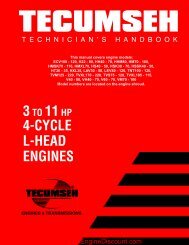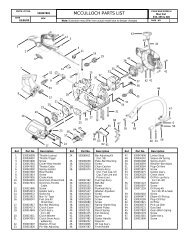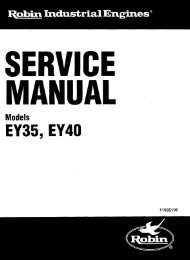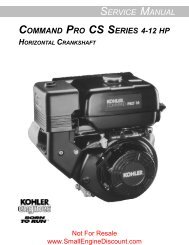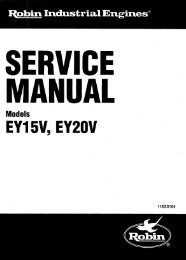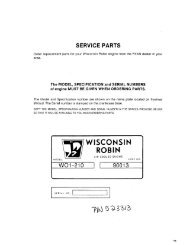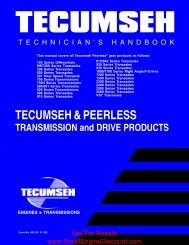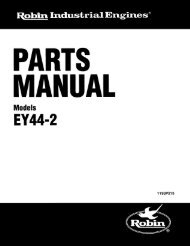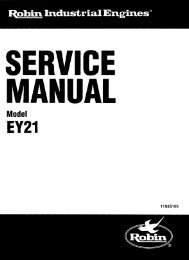4-CYCLE OVERHEAD VALVE ENGINES - Small Engine Discount
4-CYCLE OVERHEAD VALVE ENGINES - Small Engine Discount
4-CYCLE OVERHEAD VALVE ENGINES - Small Engine Discount
You also want an ePaper? Increase the reach of your titles
YUMPU automatically turns print PDFs into web optimized ePapers that Google loves.
LOW OIL PRESSURE SENSOR<br />
Test the sensor on a running engine using an<br />
ohmmeter or continuity tester with one tester lead<br />
connected the sensor terminal (with lead wire<br />
removed) and the other to an engine ground. An open<br />
circuit should be found with the engine running and<br />
continuity should exist when the engine is shut off. If<br />
continuity is found or the tractor oil pressure indicator<br />
light is on or comes on at low engine RPM's, remove<br />
the sensor and check engine oil pressure with a<br />
master oil pressure gauge. The oil pressure of a<br />
running engine should be above 10 p.s.i. (.700 bar).<br />
If lower than 10 p.s.i. (.700 bar), an internal engine<br />
problem exists (diag. 29).<br />
LOW OIL SENSOR<br />
This sensor must use a # 194 bulb in series with the<br />
sensor for proper operation and to prevent sensor<br />
damage. Remove the sensor from the engine and<br />
attach the electrical plug. Attach a jumper lead from<br />
an engine ground to the threaded portion of the<br />
sensor. Place the keyswitch in the run position. The<br />
indicator light should come on with the tip of the sensor<br />
in air and go off when oil covers the sensor tip. The<br />
response time of the sensor is between 5 and 15<br />
seconds with 13 volts D.C. at the battery. Lower<br />
battery voltage will result in a longer response time.<br />
Use teflon-type pipe sealant on the sensor threads to<br />
prevent oil leakage when reinstalling (diag. 30).<br />
ELECTRIC STARTER SERVICE<br />
This section covers the service procedures for the 12 and 120 volt electric starters. For diagnosis of the<br />
starting circuit see “Electrical Starter Troubleshooting” in this chapter. Illustrations may not be identical in<br />
configuration to the starter being serviced, but procedures and tests apply unless otherwise stated. Starters<br />
labeled UL listed/ CSA approved are serviceable. Starters labeled CSA cannot be serviced, only replaced. If a<br />
starter is serviced, the "O" rings on each end of the housing must be replaced.<br />
12 VOLT or 120 VOLT ELECTRIC STARTERS<br />
1. Remove the plastic dust cover on the bendix<br />
end (diag. 31).<br />
48<br />
2. Push down the spring retainer and remove<br />
the retainer ring.<br />
3. Slide off the spring retainer, anti-drift spring,<br />
gear, and drive nut.<br />
4. If internal service is necessary (non-CSA)<br />
starters only, scribe a line across the cap<br />
assemblies and armature housing to aid in<br />
reassembly.<br />
5. Remove the two or four retaining nuts from<br />
the through bolts holding the cap assembly.<br />
6. Slide off the cap assembly. The terminal<br />
insulator slides out of the commutator cap<br />
(some models).<br />
7. Remove the armature.<br />
8. Inspect and replace as necessary, see the<br />
section "Inspection and Repair" later in this<br />
chapter. Use the reverse procedure for<br />
assembly. ( For ease of assembly, place the<br />
armature into the brush end of the frame first.)<br />
BRUSHES<br />
RETAINER &<br />
SPRING<br />
ARMATURE<br />
BENDIX ASSEMBLY<br />
RETAINING RING<br />
DUST COVER<br />
Not For Resale<br />
www.<strong>Small</strong><strong>Engine</strong><strong>Discount</strong>.com<br />
30<br />
GASKET<br />
29<br />
THRUST<br />
WASHER<br />
31




